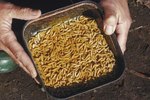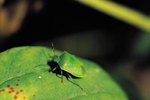
Maggots are the larvae of flies that have laid eggs and left them to develop on their own. There are as many types of maggot as there are flies and the habitats each prefers can vary greatly from one to the next. Understanding what maggots need to survive and thrive can help you better understand their chosen habitats.
Water
Some maggots, like the rat-tailed maggot, live in still pools of water. These maggots are equipped with natural tubes that allow them to breathe under water until they are mature enough to move to dry land and hatch into flies. While in the water the maggots live off any decaying organic materials available to them, such as dead plant or animal droppings. Moth fly maggots also live in stagnant pools of water, like cesspools or garbage bins, until adulthood. The maturation process typically takes 2 to 3 weeks.
Rotting Meat
Blow or bottle fly maggots are called calliphorid, and are found most commonly in rotting meat throughout the United States. These maggots hatch from eggs laid by adult flies in rotten meat and dead animals. The maggots eat the meat to fuel their growth until reaching a pupate stage, during which they enter a red cocoon and transform into flies. Maggots will leave their decaying food source to find a suitable place to pupate. Often during this journey maggots may be discovered in open areas, like carpets or countertops.
Vegetables and Fruit
Fruit flies lay their eggs in fruit and vegetables that have begun to turn. Spoiled organic matter produces sugar and alcohol, both of which attract fruit flies. The flies lay eggs in rotting fruit and vegetables, so the maggots that hatch will have ample food to support their development. Fruit fly larvae take only a few hours to hatch and only a week or so to develop into full grown flies. As the name suggests, fruit fly maggots are common to fruit and vegetables, but also can be found in garbage containers, cleaning materials or anywhere rotting food is found.
Living Creatures
In some cases, maggots will live and develop inside a living creature. The odors that emanate from infected areas, cuts or open wounds can mimic those of a decaying animal and, thus, attract flies. The flies lay eggs and maggots develop, which then eat the nearby rotten or infected tissue. Once the diseased flesh is gone, the maggots begin to dissolve healthy tissue by releasing digestive enzymes. These toxic chemicals result in burrows that allow the maggot to continue eating and growing into an adult fly.
References
Resources
Photo Credits
-
Ablestock.com/AbleStock.com/Getty Images
Writer Bio
Robert Morello has an extensive travel, marketing and business background. He graduated with a Bachelor of Arts from Columbia University in 2002 and has worked in travel as a guide, corporate senior marketing and product manager and travel consultant/expert. Morello is a professional writer and adjunct professor of travel and tourism.



